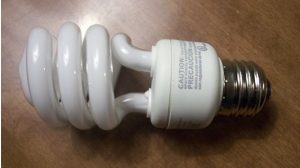Sure compact fluorescent light bulbs (CFLs) use less electricity, but don’t they contain mercury? What happens if one breaks in my house? How do I safely dispose of a CFL?
 While we are all trying to reduce our energy use, it’s good to question whether the alternatives are truly better – both for the environment and for our own health. There are actually a number of concerns that have been raised over the safety and health of CFL use. These include the presence of mercury, UV radiation, electric and magnetic field (EMF) concerns, and fire risk concerns. Let’s look at each of these separately.
While we are all trying to reduce our energy use, it’s good to question whether the alternatives are truly better – both for the environment and for our own health. There are actually a number of concerns that have been raised over the safety and health of CFL use. These include the presence of mercury, UV radiation, electric and magnetic field (EMF) concerns, and fire risk concerns. Let’s look at each of these separately.
Mercury:
From the reading I’ve done, it sounds like the risks posed by the small amounts of mercury contained in a CFL are very low – the amount would cover the tip of a ballpoint pen. This level, approximately 2.5mg, is less than is found in a watch battery, and is much less than is emitted by a coal-fired power plant to generate the electricity to run a comparable incandescent bulb.
UV Radiation:
Health Canada released a study in 2009 which looked at both the UV and EMF risks posed by CFLs. The study found that the UV risks from these bulbs are very low for most people, but they do recommend that you sit more than 30cm away from a bulb as a precaution. So don’t sit too close! Those with auto-immune disorders may be more sensitive to UV from CFLs, and can look for bulbs with an additional glass cover that will filter out all UV rays.
Electric and magnetic fields:
All electronic appliances in your home and office emit EMFs. In comparison to other appliances, the EMFs emitted by a CFL are very low even at a close distance. The same Health Canada study mentioned above looked at four aspects of EMFs: Electromagnetic emission frequencies, electric field intensity, magnetic flux density, and dirty electricity. In all of these areas, the risks were found to be not significant.
Fire Risk:
I have never experienced this while using a CFL, but according to the experts, it is completely normal for CFL bulbs to smoke and show signs of melted plastic on the ballast when they burn out. This is the bulb’s built-in safety feature. You can use a CFL in both recessed and enclosed light fixtures, just not in 100% airtight fixtures. If the bulb you are buying cannot be enclosed, the packaging and bulb ballast will say so.
Cleaning up a broken CFL:
Several of the resources listed below go into greater detail, but the main steps are:
- Open the window, close the door and leave the room for at least 15 minutes.
- Scoop up the broken glass with two pieces of cardboard. Do not use a broom or a vacuum.
- Use sticky tape to pick up any leftover glass or powder.
- Place all broken pieces and clean-up materials in a glass container with a tight fitting lid, and take to a household hazardous waste depot.
Disposing of CFLs:
You should never put burnt CFL bulbs in your regular garbage. You can bring them to any Home Depot or Ikea location for recycling, or you can take them to a household hazardous waste depot.
Have any other thoughts on CFLs? Please share your comments with us and other Green Action Centre readers.
Also, see what other green myths we have taken on!



See excellent documentary The Lightbulb Conspiracy aka Pyramids of Waste, a documentary on planned obsolescence (2010)
See http://www.youtube.com/watch?v=I5DCwN28y8o
Quick note… very few cfl’s are rated for enclosed fixtures.. from my business I’ve checked Philips/Sylvania/GE/Turolight/Ushio and a whole lot of others. The only one so far is Panasonic.
Good job,
Andrew
Very small amount of mercury used in CFL.
Coal fired power plant produce huge amount of Mercury. Exhausted to the air. The best of two evils.
Solution is to recycle.